The historic Ralston District of Mendham Township, between Morristown and Chester in Morris County, is named for a wealthy Philadelphia merchant who opened a general store along the Washington Turnpike (now Route 24) in 1781. John Ralston and his partner, Hugh Nesbitt, came to Mendham to trade local goods–made from iron, peaches and apples–for staples like cotton, tobacco, and molasses from up and down the East Coast. Ralston's daughter, Mary Ann, married her father's partner's son, Hugh Jr., and had three children. One of these, John Ralston Nesbitt, built a gristmill in partnership with his mother in 1848, along the turnpike on the border of Mendham and Chester Townships.
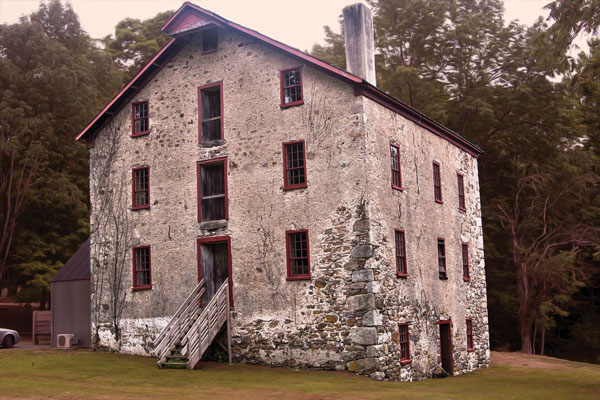
For nearly 60 years, Nesbitt's stone mill ground grain into flour and feed, powered by a wheel 16 feet in diameter and 8 feet wide, pushed by mill pond water from the Burnett Brook at the rate of 7 rpm. The venture was not unusual. This area, previously known as Roxiticus, had long been recognized as a place of mills and for the water-powered industries built up around the North Branch of the Raritan River and its tributaries. Nesbitt's mill was remarkable only for the placement of the wheel and race in the center of the structure to protect it from winter ice. John ran the mill, employing only one assistant, until 1904 when he died in the building's top story of apparent heart trouble.
Four years later, Thomas Laughlin bought the old mill, but he did not intend to grind grain. Laughlin had purchased the most prominent distillery in the area and decided to move the production plant for Tiger Applejack to what was to become the Ralston Cider Mill.
Since the mid 1700s, apple cider and applejack were produced and consumed on some scale in nearly every community across the temperate regions of North America in quantities that far exceeded wine, beer and whiskey. Supplies of water in the Old World had become short, widely polluted by agriculture and industry, and cider had long been the staple drink in many parts of Europe. Water in the New World was avoided out of fear, and early American colonists, well versed in cider production, found apples were easy to grow in the Northeast. Cider served as the base for vinegar, employed to pickle and preserve fruits and meats. Brandy and a variety of mulled beverages were consumed to cure illness and ease pain. Applejack was an antiseptic, a sedative, and a stimulant. Cider and brandy were blended for drinking at social occasions as well.
To convert Nesbitt's Mill for cider pressing, Laughlin first reinforced the hand-hewn oak beams along the breadth of the first floor with several steel I-beams. Below ran the race, where Laughlin sank a cast-iron turbine to replace the worn-out wooden wheel. Water piped directly through the penstock to the turbine fins transferred power for every function of the mill through a single line shaft rising vertically through the floors above. Overhead sat giant custom-built oak vats that would hold the cider to be dispensed through spigots installed in their bottoms.
Standard cider mills of the day were in a specialized form: three stories, with the bottom two usually below grade, and the top floor at road level to unload apples, avoiding a hoist to the grinder. However, at Nesbitt's mill, built for grist, an apple elevator lifted washed and sorted fruit from a storage bin outside to the third (top) floor of the mill. Only the millrace, the wheel, and now the turbine, were below grade. From inside the basement, a special conveyor would also move peaches upward into the mulcher.
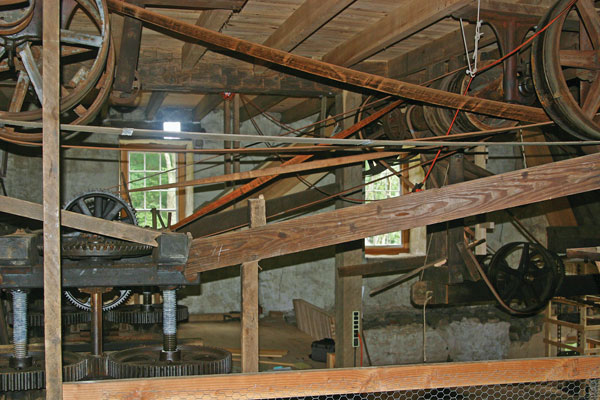
At the building's apex, through a maze of appropriately sized pulleys and belts the turbine's shaft began its transfer of power to the mill machinery. First, the grater, a small cylinder equipped with blades spinning at 2,000 rpm, received apples dropped from the elevator and turned them into pomace. From the floor below, an operator controlled the grater, and the flow of pomace through a chute into prepared racks, each about 4 feet square and 6 inches deep. When the pomace reached the level of the top of the form, cloth was folded over to make a bundle, the form was removed, and another set up to pour. The racks were stacked five or six high in the press to form the “cheese”. While one cheese was in the press, another was assembled.
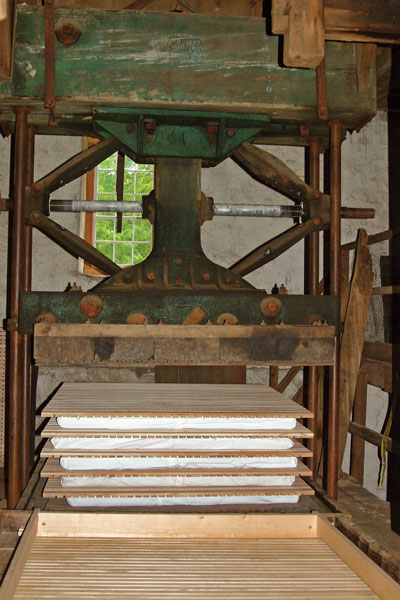
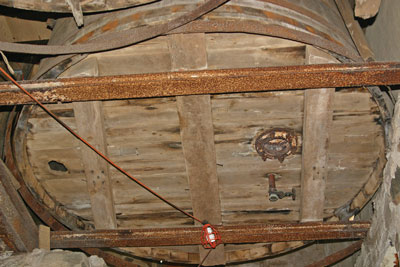
The pressing equipment at the Ralston Cider Mill, either newly acquired or relocated from Laughlin's previous distillery location, was manufactured by the Boomer and Boschert Company, founded in 1874 to produce these marvels of mechanical engineering. Two presses were used, one of which was a knuckle joint press that operated much like a modern-day automobile scissors jack. The second, a gear or screw press, employed sophisticated multi-speed drives designed to extract as much juice as possible from the apples, a device that minimized friction between the screws and washers, and a mechanical gauge that measured the pressure exerted by the press. The press could process 10,000 pounds of fruit a day, or about 1,100 gallons of cider.
The pressed juice flowed through copper pipes into immense collection vats, and the squeezed-out pomace found its way to livestock feed-troughs at local farms. Entire treatises have been written on the manufacture of cider and its by-products, but the bare bones is this: As the mixture settled, liquid was dispensed into smaller barrels for racking. For several weeks the fresh cider bubbled as natural-occurring yeasts converted carbohydrates into alcohol. When the frothing slowed, the barrels were corked and sat for several more weeks with the cork being gradually tightened to prevent the cider from turning to vinegar. Clear liquid was drawn off as suspended sediment continued to settle until the casks were finally sealed, usually by late spring of the next year.
It required 10 gallons of cider to produce 1 gallon of applejack. The cider was boiled in a large still, the condensed vapors collected in a second boiler, then distilled a second time. The first run produced spirits 60-80 proof; the second 110-130 proof. Diluting the stronger brew with water produced a finished product around 100 proof, or 50% alcohol. The applejack then moved to clean barrels for aging, for three to five years. Peach brandy was produced in a similar manner; the juicier fruit yielding far more product when pressed.
By the time the mill at Ralston squeezed its first drop of cider, the brandy industry in New Jersey was more than 130 years old, having begun in Morris County in 1773 with the production of “Jersey Lightning”. By 1830, the county had 53 working brandy stills, second only to Hunterdon. In 1850, a quarter of Mendham's 171 farms reported some income from apples. The industry peaked at the turn of the 20th Century with 29,142 barrels of cider and 6,276 barrels of vinegar. By 1899 New Jersey was the national leader in cider production; the net value of state's brandy crop for the year comprised 23% of the US total.
The new century brought increased urbanization, higher taxes, and the rise of the great wheat-producing agricultural centers in the Midwest. Beer began to replace cider as the drink of choice. By 1919, cider production on US farms was down 77%. New Jersey brandy production was cut to 1/3 of 1899's output.
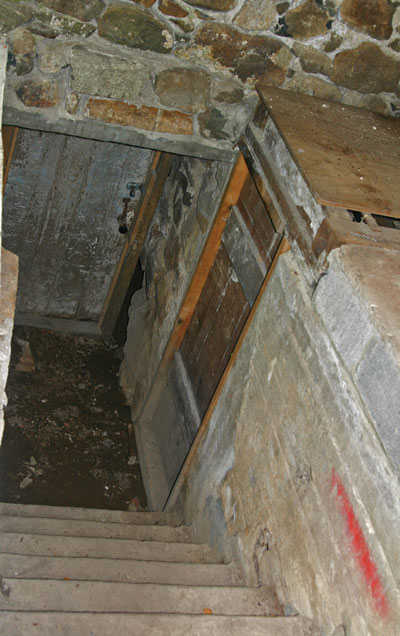
Then there was Prohibition. Because it was far more reliable and safer than “bathtub gin” and other bootleg liquors, many drinkers turned to brandy. During Prohibition, nearly every drop of New Jersey cider was distilled into brandy. The still at Ralston moved behind closed doors to a shed beside the mill. A chimneystack from the shed's furnace shared the smoke from the underground distillery in an effort to conceal the illegal operation. A sliding panel obscured the shed's door, and barrels of brandy hid under a false floor in a garage behind the mill.
In 1929, Sammy Fornaro came from Naples, Italy and bought the Nesbitt mill. When Prohibition ended in 1933, the Fornaro family obtained a liquor license and opened a restaurant across the street called Sammy's Cider Mill. The restaurant was to enjoy a long and prosperous future, but for the mill, the die was cast. The liquor industry became heavily regulated, and wheat-based whiskey was far cheaper to produce. And the apple orchards began to disappear in a New Jersey landscape increasingly populated by suburban homes. In 1938 the mill shut down.
Of all the cider mills in New Jersey, Nesbitt's is the only survivor. For seventy years the stone building sat on some of the most valuable real estate in the world, somehow avoiding adaptive reuse or the bulldozer. The mill sat, essentially sealed, until members of the Mendham Historic Preservation Committee opened it to the Township Committee and residents in order to demonstrate its potential. Much of the machinery had fallen through rotted floors to the mill basement, but most remained intact, or fully salvageable. The township purchased the property using county matching Green Acre funds, but only after agreement that a not-for-profit corporation be formed to restore and operate the museum, leasing it from the township. In 2004, original trustees--Raymond Nadaskay, Architect; Anthony Bastardi, Contractor; Carolyn Daly, Esq.; and Patricia Maynard--applied for and received grants from public funds, foundations and private individuals to create a Preservation Plan. Millwrights Jim and Pete Kricker, of Rondout Woodworking Inc. in Saugerties, NY, began work in 2005, restoring the mill structure, windows and equipment and rehabilitating the metal shed that hid the still. The gears, pulleys and presses are original, this time powered by an electric motor and linked with belts that are, in some cases, replacements.
This fall, you will be able to experience a rare instance of a remarkable technology, so vital to the heritage of our state. Nesbitt's Mill is open public visitation and demonstration, weekends in October and the first two weekends in November. There are plans for a visitor center and parking lot—along with facilities within the mill to insure an enhanced visitor experience—including lighting, enhanced displays, and an introductory DVD presentation. Jim and Pete Kricker will continue, although on a less frequent basis, to refine and restore the site.
The Cider Mill Museum will be open the last two weekends in September through October. Adults $5, Children Free. The museum is also open to groups by appointment. Please keep an eye on their website for fresh developments and to confirm times.
The cider you find in the supermarket is "flash pasteurized" and often loaded up with preservatives and sweeteners to extend shelf-life. But you can still find fresh cider here and there at local farms. Even more unusual is the local farmer who makes his own. Making cider is relatively simple but has always required skilled craftsmen. Picking apples at the right time, storing them properly, and processing in a timely fashion are all critical. And a skilled cider miller might blend a variety of fruit--one for sweet, one for tart, one for fragrance--to create cider to write home about. Fortunately there are a few fine local cider-makers in our area.
Beemerville Orchards in Sussex (973/875-1029), and Ochs Orchard, just over the Sussex County line in Warwick, NY (845/986-1591), both make cider until their supplies of apples run out, usually well into the winter or early spring. It takes one bushel of apples to make three and a half gallons.
The process is pretty much the same as in the "old days." The apples are sorted and washed, ground into pomace and pumped into frames. The cheeses are stacked fourteen high in hydraulic, rather than purely mechanical, presses. And the cider squeezes out into stainless steel tanks. On a fast day these local presses can put out 1,000 -2,000 gallons, most of it available only for their own customers.
At Ochs Orchard the new cider is pumped into a filter system and passes through an ultra-violet processor to kill any possible bacteria. The UV also kills some of the yeast in the apples yielding 8 to 10 extra days before fermentation. At Pochuck Valley Farms, the cider is pumped into a holding tank with no other processing. The entire process is done cold to preserve the taste and flavor of the apples and to inhibit fermentation. Even so, it takes three weeks before hardness starts.
Fresh local cider gets tastier as fall progresses, as more kinds of apples become available, and as they sweeten in storage. For example, Winesap, introduced to the mix for tang, doesn't ripen until later in the fall. Among others, Red Delicious is added for sweetness, McIntosh and Empire for body. In any case, you'll get the best cider after Halloween.
Even today, if you needed a natural hideout—a really good one—Jonathan’s Woods could work.
Dedicated to preserving the heritage and history of the railroads of New Jersey through the restoration, preservation, interpretation and operation of historic railroad equipment and artifacts, the museum is open Sundays, April thru October.
The Millstone Scenic Byway includes eight historic districts along the D&R Canal, an oasis of preserved land, outdoor recreation areas in southern Somerset County
The Jacobus Vanderveer house is the only surviving building associated with the Pluckemin encampment.
Part of the Morristown National Historic Park, the formal walled garden, 200-foot wisteria-covered pergola, mountain laurel allee and North American perennials garden was designed by local landscape architect Clarence Fowler.